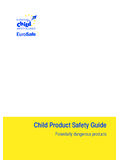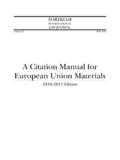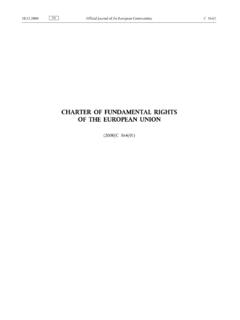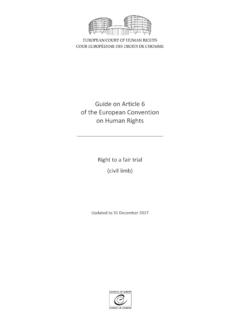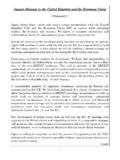Transcription of Official Journal of the European Union - gmsinc.net
1 An analysis of the European Regulation on ship recycling* by Dr Nikos Mikelis Non executive Director, GMS Dubai Introduction On the 30th December 2013 the European Union brought into force the European Regulation on ship recycling (thereafter referred to as the ER) to regulate the safe and environmentally sound recycling of European flag ships, and also to require, in a few years time, the carriage on-board of inventories of hazardous materials for all ships visiting European ports. The entry into force of the ER is a significant event that will not only change the way ships under its scope are recycled, but also promises to bring changes to the contractual relations between Cash Buyers, shipowners and recycling yards.
2 GMS, as the world s leading Cash Buyer, has followed closely the development of the ER and has a good understanding of its provisions. With this article GMS shares its expertise, so as to facilitate the application of the new European requirements. Background The new Regulation evolved from text, originally proposed by the European Commission on 23 March 2012, through lengthy internal negotiations amongst the 27 Member States of the European Council, as well as through the deliberations of the European Parliament s Environment Committee.
3 Thereafter tripartite meetings were held between the Council, the Parliament and the Commission and at their third trilogue meeting, on 27 June 2013, an agreement was reached on a final compromise package. This agreement was formally adopted by the plenary of the European Parliament on 22 October 2013 and by the European Council on 15 November 2013. It was published on 10th December 2013 in the Official Journal of the European Union and on the 30th of December 2013 the new European Regulation on Ship Recycling (the ER) entered into force.
4 The outcome of the European initiative and negotiations is that the ER is very similar to the Hong Kong Convention (hereafter, the HKC), encompassing most of its mechanisms, and, with one potential exception, containing no contradictory provisions that could create an impediment to the prospects of the HKC s entry into force. In fact, it is very possible that the ER could significantly accelerate the date when the HKC becomes the global standard for regulating the recycling of ships. The original text proposed by the European Commission had numerous problematic provisions, probably proposed without a full appreciation of the commercial realities of international shipping.
5 Also, some key policies of the European Parliament were based on a na ve understanding of the recycling industry and appeared to have been pursued without regard to their consequences to the shipping industry, to the recycling industries, to the prospects of the HKC, and even to the enforceability of the ER. Knowledgeable and focused technocrats from the Cypriot and the Irish Presidencies negotiated a final text that is workable and supportive of the HKC, having overruled most of the unworkable and counterproductive proposals.
6 The result of the lengthy and complex negotiations produced text that is difficult to read, with frequent and convoluted cross-references. Admittedly, this is a small price to pay for having been spared an unworkable piece of legislation. * This article will appear in BIMCO s Bulletin No. 6/2013 Scope The types and sizes of ships that come under the scope of the ER are the same as under the HKC, except the ER being restricted to European Union flag ships, with an additional requirement for ships of other flags visiting EU ports to be provided with an inventory of hazardous materials (IHM).
7 Control of hazardous materials and IHMs With regard to the control of certain hazardous materials and the need to compile and carry on board a ship-specific IHM, the ER is structured in the same way as the HKC, requiring the three-part IHM to be compiled taking into account the guidelines of the HKC. Like the HKC, the ER now differentiates between existing ships and newbuildings, with existing ships having to identify at least those materials on board that are listed in ER s Annex I, while newbuildings are being prohibited to be fitted with materials listed in Annex I and also being required to identify (location and approximate quantities) materials listed in ER s Annex II.
8 One important difference between the ER and the HKC, is in the inclusion of one extra hazardous material, which is already banned in European Union law, in Annex I of the ER (Perfluorooctane sulfonic acid and its derivatives, or PFOS, the main application on board ships being in some fire fighting foams), and another one in Annex II (Brominated flame retardant, or HBCDD, the main application on board ships being in expanded polystyrene used for cryogenic insulation, such as for liquefied gas tanks but also for refrigerator areas).
9 A relevant footnote in Annex I to the ER states that PFOS is not applicable to ships flying the flag of a third country , while the HBCDD, being a material of Annex II, strictly speaking need only be included in IHMs of newbuildings, plus in any retrofits involving changes to structure and equipment of existing ships. As the ER treats all ships flying the flag of a third country as existing ships, regardless of their date of built (see ER s Article 12(1), referring to Art. 5(2)), it follows that inclusion of information on the HBCDD will not be required of IHMs of non-EU flagged ships, unless HBCDD has been installed during a retrofit.
10 Conversely, IHMs compiled for EU flagged ships after the date of application of the ER will fully satisfy the requirements of the HKC. Note that good descriptions of the properties and typical uses of PFOS and of HBCDD can be found in a Norwegian submission to IMO in 2008 (document MEPC 57/3/19) proposing their inclusion as controlled hazardous materials under Appendices 1 and 2 respectively of the HKC. The Norwegian submission was rejected by IMO at that time. Requirements for shipowners The scopes of three mandatory and one voluntary surveys and the maximum interval between renewal surveys in the ER are the same as in the HKC.
